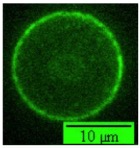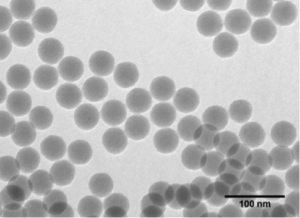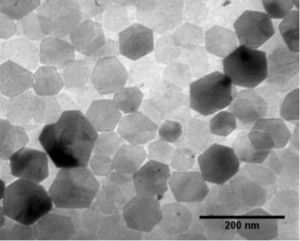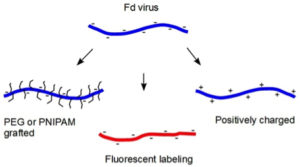Model Systems
DNA-Constructs
We employ the click chemistry of DNA to construct macromolecules with a complex architecture that would otherwise be difficult to realize with conventional methods. Molecules consisting of DNA only, and DNA-synthetic hybrids are of interest. DNA-PNIPAM hybrids open the possibility to tune interactions through variation of the temperature.
| Beads Grafted with Thick DNA Brushes
Colloidal beads are grafted with DNA, where the functionality (up to highly packed brushes) as well as the brush thickness (up to about 10 microns) can be varied. The DNA can be fluorescently backbone-labeled or end-labelled (as in the figure), to enable the investigation of the brush structure as a function of functionality, DNA length, and ionic strength. At high colloid concentrations, the deformation of the brushes due to interactions as well as brush-interpenetration can be studied. |
 A fluorescent microscopy image of a DNA-coated, end-labeled magnetic bead.
|
| DNA Duplexes
A single stranded DNA fragment connects two stiff, double stranded DNA fragments. The length of both the flexible and stiff parts can be controlled within a single-base accuracy. Depending on the spacer length and the length of the stiff strands, various phases may occur. A novel smectic phase has been found for sufficiently long spacers, where the stiff parts of each duplex reside within the same smectic layer. |
 (a) A schematic of a fully paired duplex and (b) a gapped duplex. (c) A gel electrophoresis pattern. |
Modified fd-viruses
They are natural rod-like bacteriophages (a bacterial virus) with a length of 880 nm and a diameter of 6.6 nm. Each virus consists of a single-stranded circular DNA molecule packed in a cylindrical capsid of 2700 identical major coat proteins.
| Surface Modification: Polymer Grafting and Charge Modification
Each of the 2700 major coat proteins of fd-virus bear two solvent exposed amine and five carboxyl groups that give the virus a negative charge over a wide range of pH (a TEM picture of a native fd-virus in given in the upper figure). These chemical groups are used to modify the surface of the viruses, and thus tune their mutual interactions. The viruses can be grafted with polymer chains [1], [2], fluorescently labeled, and their charge can be reversed to obtain positively charged viruses particles [3] (as schematically depicted in the lower figure). |
 TEM image of fd-virus
|
| Fd-virus Related Bacteriophages
In addition to the chemical modifications, different types of filamentous viruses and mutants of fd-viruses are used. For example, the virus fd-Y21M, which is stiffer than native fd, is used as a model-rod to study the dynamics in smectics [4], and are used in rheological studies. The various bacteriophages that we use have a contour length varying from 0.4 to 2.1 micron, with persistence lengths varying from 2.8 to 9.9 micron. |
 Two viruses with different lengths, and with different fluorescent labeling, diffusing in a smectic phase of native fd-virus. |
Synthetic Colloids
Besides the bio-inspired model systems, we develop synthetic model systems, ranging from spheres, to platelets, to rods. Surface chemistry is a means to tune the interactions between these model colloids.
| Spherical Colloids
Concerning spherical colloids, fluorinated latex particles [1], [2] and silica spheres [3], [4] have been of recent interest. |
 TEM image of silica spheres |
| Anisometric Colloids: Rods and Platelets
In addition to the bio-inspired rod-like colloids, we synthesize rods composed of boehmite, and platelets consisting of gibbsite. |
 TEM image of gibbsite platelets |

